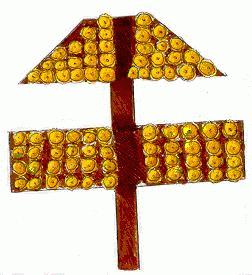

 |
International |  |
~~~~~~~~~~~~~~~~~~~~~~~~~~~~~~~~~~~~~~~~~~~~~~~~~~~~~~~~~~~~~~~~~~~~~~~~~~~~~~~~~~~~~~~~~~~~~~~~~~~~~~~~~~~~~
|
Lagerphones are not unique to Australia - well not quite ......
|
|||||||
|
.....this is a Canadian lagerphone. At least Canadian in the sense that it was made in Canada, albeit by an Australian lady, Margaret Gilks, originally from Albury, then of Ontario, now back down under in Yass. It is, or was, a spade handle of course, a variety of crown seals are fastened on more or less all the way down from top to bottom and it is bounced from the top handle. There is no rattler. Incidentally Margaret is the first female lagophonist I have yet met - if there are any more .......
|
 |
 |
 |
..... and this one is from south of the border down in the U.S. It belongs to the River Bottom Bushwhackers of Kent, Ohio (yes, home of the Kent State University) whose lagophonist Mark Bussinger describes it : '61" tall of 1½" half-round hardwood molding with a 1" square hardwood crosspiece fitted on top. The whacker/ scraper is ¼"x1" with grooves filed on the contact side. The molding provides an excellent edge and the flat surface is easier for attaching bottle tops. Two caps per roofing nail, the inner flattened and with the plastic inwards, the outer slightly flattened to give a little play and a larger sounding area. The acrylic design symbolizes the heavens, air, earth, water, man and light.'
|
|||
~~~~~~~~~~~~~~~~~~~~~~~~~~~~~~~~~~~~~~~~~~~~~~~~~~~~~~~~~~~~~~~~~~~~~~~~~~~~~~~~~~~~~~~~~~~~~~~~~~~~~~~~~~~~
|
Now to the most interesting development I have had for some time. These are Charrascos and however much they may resemble lagerphones they are an independent development. They are a local folk instrument from Galicia in Spain (the top left corner on the map - roughly from Corunna to Santiago do Compostela) and I have been told about them by my friend Jesús Cano who is apparently a local academic/musician studying such instruments. He tells me they are found in the province of Pontevedra and in the valley of the river Ulla. Jesús poses the intriguing possibility that the Holbrook rabbiter might have been a Galician immigrant who remembered his local native instrument and derived his idea therefrom. Well - possibly! I gather (Jesús and I correspond in Spanish and as my knowledge thereof is now rusty my translations may not be always accurate) that 'from antiquity' these instruments have been made from metal discs in a fashion similar to tambourines. 'They consist of a wooden pole approximately one and a half metres high on the upper part of which is an embroidery frame. From that frame a vibrating wire runs down to the middle of the handle.' Apparently a stick is then pulled across this wire to produce a sonorous tone. There are some more pictures on Jesús' own web page.
|
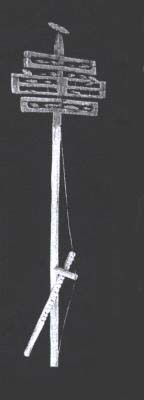 |
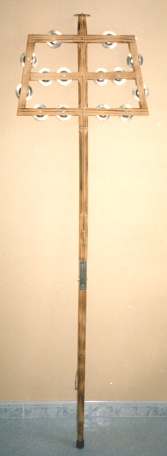 |
~~~~~~~~~~~~~~~~~~~~~~~~~~~~~~~~~~~~~~~~~~~~~~~~~~~~~~~~~~~~~~~~~~~~~~~~~~~~~~~~~~~~~~~~~~~~~~~~~~~~~~~~~~~~~~~~~~~~~~~~~~
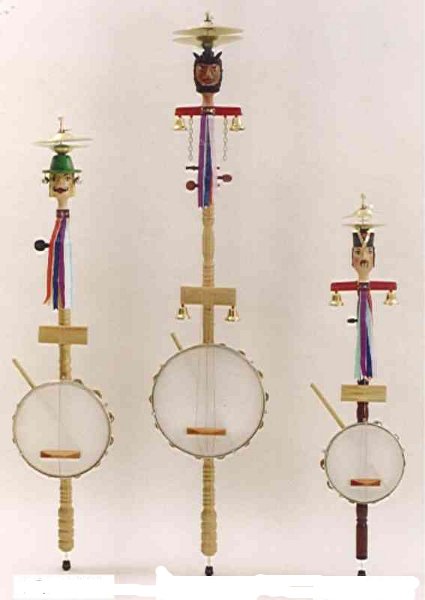 |
 |
 |
 |
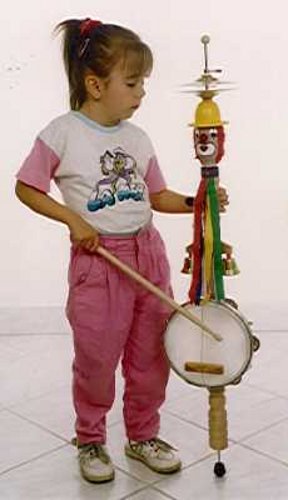 |
~~~~~~~~~~~~~~~~~~~~~~~~~~~~~~~~~~~~~~~~~~~~~~~~~~~~~~~~~~~~~~~~~~~~~~~~~~~~~~~~~~~~~~~~~~~~~~~~~~~~~~~~~~~~~~~~~~~~~~~~~~
|
And this picture I include in case anyone can recognise it and give me more information. It has come from the Vaughan Williams library at Cecil Sharpe House and is from a silent film of an international folk dance festival in South Africa in 1955. I am told it is a dutch dance group doing a couples dance and that the man in the middle is bouncing up and down something that resembles a thick walking stick. Ann Young from Sydney found and viewed the film when she was in London researching her thesis on folk dancing in international culture. She suggests that the walking-stick man "may be some kind of a conductor/percussionist. I do not think he would be there if it were not traditionally done." And unfortunately that is all I have to go on - apparently there is no more history available. If it might mean anything to anyone and you should chance to be in London I am told it appears towards the end of Video 85 and that when my brother went seeking it on my behalf the librarian and his staff were exceedingly helpful. I would be most pleased to hear from anyone who, having viewed it, might be able to offer more information. This could be another precursor to, or at least something akin to, our own lagerphone.
|
 |
~~~~~~~~~~~~~~~~~~~~~~~~~~~~~~~~~~~~~~~~~~~~~~~~~~~~~~~~~~~~~~~~~~~~~~~~~~~~~~~~~~~~~~~~~~~~~~~~~~~~~~~~~~~~~~~~~~~~~~~~~~
And finally a news item which I record with a degree of astonishment - lagerphones have made the move from being only a folk instrument into the classical world - at least as an accompaniment. The person who has made that transition is David Bruce, a composer from St. Albans in England whose piece 'Piosenki' incorporates a lagerphone and had its premiere in no less august a place than Carnegie Hall in New York! David tells me it was accorded several favourable reviews including one in the New York Times .
~~~~~~~~~~~~~~~~~~~~~~~~~~~~~~~~~~~~~~~~~~~~~~~~~~~~~~~~~~~~~~~~~~~~~~~~~~~~~~~~~~~~~~~~~~~~~~~~~~~~~~~~~~~~~~~~~~~~~~~~~~

|

|

|

|

|